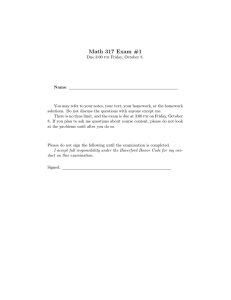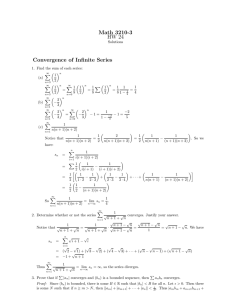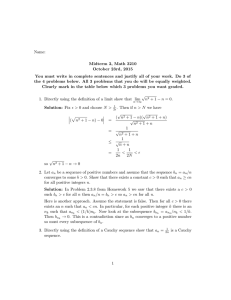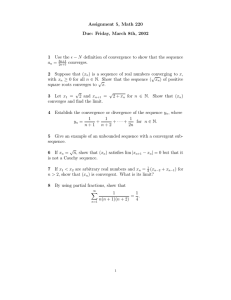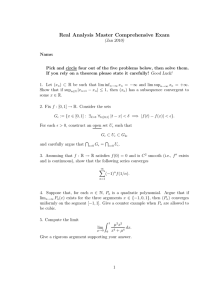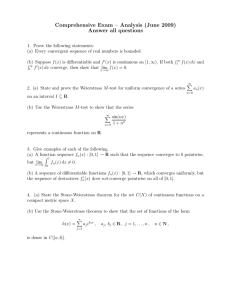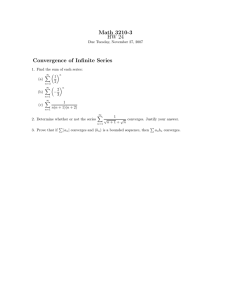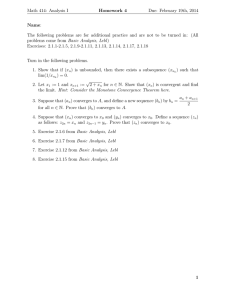Solutions to Take-Home Part of Math 317 Exam #1
advertisement
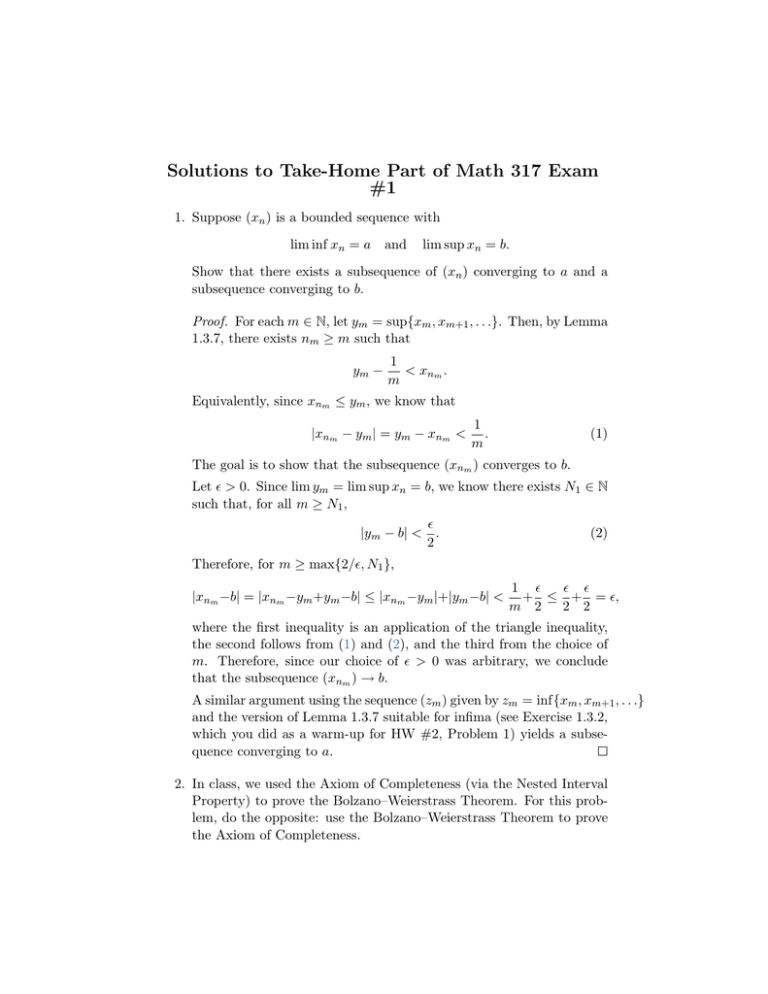
Solutions to Take-Home Part of Math 317 Exam
#1
1. Suppose (xn ) is a bounded sequence with
lim inf xn = a and
lim sup xn = b.
Show that there exists a subsequence of (xn ) converging to a and a
subsequence converging to b.
Proof. For each m ∈ N, let ym = sup{xm , xm+1 , . . .}. Then, by Lemma
1.3.7, there exists nm ≥ m such that
ym −
1
< xnm .
m
Equivalently, since xnm ≤ ym , we know that
|xnm − ym | = ym − xnm <
1
.
m
(1)
The goal is to show that the subsequence (xnm ) converges to b.
Let > 0. Since lim ym = lim sup xn = b, we know there exists N1 ∈ N
such that, for all m ≥ N1 ,
(2)
|ym − b| < .
2
Therefore, for m ≥ max{2/, N1 },
|xnm −b| = |xnm −ym +ym −b| ≤ |xnm −ym |+|ym −b| <
1 + ≤ + = ,
m 2
2 2
where the first inequality is an application of the triangle inequality,
the second follows from (1) and (2), and the third from the choice of
m. Therefore, since our choice of > 0 was arbitrary, we conclude
that the subsequence (xnm ) → b.
A similar argument using the sequence (zm ) given by zm = inf{xm , xm+1 , . . .}
and the version of Lemma 1.3.7 suitable for infima (see Exercise 1.3.2,
which you did as a warm-up for HW #2, Problem 1) yields a subsequence converging to a.
2. In class, we used the Axiom of Completeness (via the Nested Interval
Property) to prove the Bolzano–Weierstrass Theorem. For this problem, do the opposite: use the Bolzano–Weierstrass Theorem to prove
the Axiom of Completeness.
Proof. This will follow in two parts.
Lemma 0.1. The Bolzano–Weierstrass Theorem implies the Nested
Interval Property.
Proof. Let In = [an , bn ] for each n so that I1 ⊇ I2 ⊇ I3 ⊇ . . .. For
each n,
a1 < bn ≤ b1 ,
so the sequence (bn ) is bounded. By the Bolzano–Weierstrass Theorem, it contains a convergent subsequence (bnk ) → b.
I claim that b ≤ bn for all n. To see this, note that (bn ) and (bnk ) are
both decreasing sequences since the intervals are nested. If b > bm for
some m, then for all k ≥ m we have nk ≥ nm ≥ m, so bnk ≤ bnm ≤
bm < b and
|bnk − b| = b − bnk ≥ b − bm .
This is clearly impossible since b − bm is a fixed positive number and
the sequence (bnk ) converges to b. Therefore, b ≤ bm for all m.
On the other hand, b ≥ an for all n. This follows because, for any n,
bnk ≥ an , so, by the Order Limit Theorem, b = lim bnk ≥ an .
Therefore, we see that an ≤ b ≤ bn for all n, so b ∈ In for all n,
meaning that
∞
\
b∈
In ,
i=1
so the intersection is non-empty. Since our choice of nested intervals
was arbitrary, we conclude that the Nested Interval Property is true.
Lemma 0.2. The Nested Interval Property implies the Axiom of Completeness.
Proof. Let A be a non-empty set of real numbers that is bounded
above. Since A is non-empty, there exists some number a1 that is not
an upper bound for A. Since A is bounded above, there exists an upper
bound b1 for A. Then a1 < b1 . Let I1 be the closed interval [a1 , b1 ],
which has length d = b1 − a1 > 0. If the midpoint of the interval,
1
m1 = a1 +b
is an upper bound for A, let b2 = m1 and let a2 = a1 ;
2
otherwise, let a2 = m1 and let b2 = b1 . Define I2 = [a2 , b2 ]. Now we
n
can iterate this process. For any n, let mn = an +b
2 : if mn is an upper
bound for A, let bn+1 = mn and an+1 = an ; otherwise, let an+1 = mn
and bn+1 = bn . Either way, we define In+1 = [an+1 , bn+1 ].
This process yields the nested intervals I1 ⊇ I2 ⊇ . . . such that the left
endpoint of each interval is not an upper bound
T for A and the right
endpoint is. By the Nested Interval Property, ∞
n=1 In contains a real
number b. I claim that b = sup A. First, I want to show that b is an
upper bound for A. Suppose it were not. Then there would be some
a ∈ A such that a > b. Let 0 = a − b > 0. Since each bn was chosen
to be an upper bound for A, we know a ≤ bn for all n. But then, for
any N > d0 ,
bN − b ≥ a − b = 0 ,
This is clearly impossible, since b ∈ IN = [aN , bN ], which has length
d
d
<
< 0 .
N
2
N
To see that b is the least upper bound, let > 0. Let N > d . Then,
since none of the an ’s is an upper bound for A, there exists a ∈ A such
that aN < a ≤ bN . Now, both a and b are elements of [aN , bN ], which
has length 2dN , so
d
d
< .
|b − a| ≤ N <
2
N
Therefore, since |b − a| = b − a, we see that b − a < or, equivalently,
b − < a. Since our choice of > 0 was arbitrary, Lemma 1.3.7 implies
that b = sup A.
Combining Lemmas 0.1 and 0.2, we see that the Bolzano–Weierstrass
Theorem implies the Nested Interval Property and the Nested Interval
Property implies the Axiom of Completeness, so we conclude that the
Bolzano–Weierstrass Theorem implies the Axiom of Completeness.
3. Define the sequence (xn ) recursively by setting
√
x1 = 2
√
xn+1 = 2 + xn for all n ∈ {1, 2, 3, . . .}
(a) Show that the sequence (xn ) converges.
Proof. I will use induction to show that (xn ) is a bounded, increasing sequence; then the Monotone Convergence Sequence will
imply that it converges. Specifically, I claim that, for all n ∈
{1, 2, 3, . . .},
√
2 ≤ xn ≤ xn+1 ≤ 2.
p
√
√
Base Case: Clearly, since x1 = 2 and x2 = 2 + 2,
√
2 ≤ x1 ≤ x2 ≤ 2.
√
Inductive Step: Suppose 2 ≤ xk ≤ xk+1 ≤ 2. Then
p
√
xk+2 = 2 + xk+1 ≤ 2 + 2 = 2.
Also,
xk+2 =
p
2 + xk+1 ≥
√
2 + xk = xk+1 ≥
√
2,
since xk+1 ≥ xk . Putting these two together, we see that
√
2 ≤ xk+1 ≤ xk+2 ≤ 2.
√
Therefore, by induction, we conclude that 2 ≤ xn ≤ xn+1 ≤ 2
for all n ∈ {1, 2, 3, . . .}. This means that (xn ) is a bounded,
increasing sequence, so it converges.
(b) Let λ = limn→∞ xn . Show that λ2 − λ − 2 = 0.
Proof. Consider the subsequence (xn+1 ) = (x2 , x3 , . . .). This is a
subsequence of a convergent sequence, so Theorem 2.5.2 implies
that λ = lim xn+1 . On the other hand, by the Algebraic Limit
Theorem
λ2 = (lim xn+1 )2 = lim x2n+1 = lim(2+xn ) = 2+lim xn = 2+λ.
Therefore, we have that λ2 = 2 + λ or, equivalently,
λ2 − λ − 2 = 0,
as desired.
4. A point x is called a cluster point of the sequence (xn ) if for every
> 0 there are infinitely many values of n with |xn − x| < .
(a) Show that x is a cluster point of (xn ) if and only if there is a
subsequence of (xn ) that converges to x.
Proof. (⇒) Let x be a cluster point of (xn ). By the definition
of a cluster point, for any k ∈ {1, 2, 3, . . .}, there exist infinitely
many values of n such that |xn − x| < 1/k. Pick one and call it
nk . Then I claim that the subsequence (xnk ) converges to x. To
see this, let > 0 and pick N > 1 . Then, for any k ≥ N ,
|xnk − x| <
1
1
≤
< .
k
N
Since our choice of > 0 was arbitrary, we conclude that (xnk ) →
x.
(⇐) Suppose there is a subsequence of (xn ) that converges to x.
Call the subsequence (xnk ). Let > 0. Then, since (xnk ) → x,
there exists N ∈ N such that, for all m ≥ N ,
|xnm − x| < .
Since there are infinitely many m ≥ N , we see that x is a cluster
point of (xn ).
(b) Show that (xn ) converges to x if and only if the sequence is
bounded and x is its only cluster point.
Proof. (⇒) Suppose (xn ) → x. Then the sequence (xn ) is bounded
by Theorem 2.3.2. By Theorem 2.5.2, every subsequence of (xn )
also converges to x. Therefore, since a number is a cluster point
if and only if some subsequences converges to it (by part (a)), x
is the only cluster point of (xn ).
(⇐) Suppose (xn ) is a bounded sequence with a single cluster
point x. Since x is the only cluster point, part (a) implies that
every convergent subsequence of (xn ) converges to x. Since (xn )
is bounded, HW #5 Problem 4 implies that (xn ) → x.
5. Let (xn ) be a sequence of real numbers such that |xn − xn+1 | ≤
all n ∈ {1, 2, 3, . . .}. Show that (xn ) converges.
1
2n
for
Proof. Let > 0. Choose N ∈ N such that N > 1 − log2 . Then, for
any n > m ≥ N ,
|xm − xn | = |xm − xm+1 + xm+1 − xm+2 + . . . + xn−1 − xn |
≤ |xm − xm+1 | + |xm+1 − xm+2 | + . . . + |xn−1 − xn |
1
1
1
≤ m + m+1 + . . . + n−1
2 2
2
1
1
1
= m 1 + + . . . + n−m−1 .
2
2
2
The sum inside the parentheses is less than 2, so we see that
|xm − xn | <
1
1
1
· 2 = m−1 ≤ N −1 < .
2m
2
2
Therefore, since our choice of > 0 was arbitrary, we see that (xn ) is
a Cauchy sequence and thus, by Theorem 2.6.4, converges.
